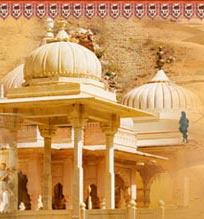 |
The Amber fort is one of the strongest forts of Rajasthan. Amber fort was once the bastion of the Kachhwaha Rajputs.
|
Amber Fort
Amber (Amer) is situated about 11 kilometers from Jaipur. It was once the citadel of the ruling Kachhawa clan of Amber, before the capital was shifted in the plains to present day Jaipur. The Amber Fort set in picturesque and rugged hills is a fascinating blend of Hindu and Mughal architecture. Constructed by Raja Man and completed by Sawai Jai Singh I, the fort is made in red sand stone and white marble. The rugged forbidding exterior belies an inner paradise with a beautiful fusion of art and architecture. Amber is the classic and romantic fort- palace with a magnificent aura. The interior wall of the palace depicts expressive painting scenes with carvings, precious stones and mirror settings. In the foreground is the Maota Lake, providing a breathtaking look.
All the means of survival and luxuries for the royal families and the people who were concerned with the functioning of this small kingdom of the Kachhawas were well provided. The Rajputs who had apparently won a small structure passed on by Meena tribes, later on renovated it into the grand Amber Fort. Holding a history as old as 7 centuries, this place vibrates with its legendry past, in the archaeological history. Although many of the early structures have been literally ruined but at the same time, those dating from the 16th century on are remarkably preserved by sincere efforts
The fort has 4 sections, each with the premises, and one has to climb up through the imposing stairway or else the broad aisle, where one can ride on the elephant back for royal feel. The Surajpol (main gate), leads to the Jaleb chowk, (the main courtyard from where one can walk up the stairway), which leads to the palace. Jaleb Chowk was also the area where returning armies were welcome and they would display their war earnings to the population at large.
All the means of survival and luxuries for the royal families and the people who were concerned with the functioning of this small kingdom of the Kachhawas were well provided. The Rajputs who had apparently won a small structure passed on by Meena tribes, later on renovated it into the grand Amber Fort. Holding a history as old as 7 centuries, this place vibrates with its legendry past, in the archaeological history. Although many of the early structures have been literally ruined but at the same time, those dating from the 16th century on are remarkably preserved by sincere efforts
The fort has 4 sections, each with the premises, and one has to climb up through the imposing stairway or else the broad aisle, where one can ride on the elephant back for royal feel. The Surajpol (main gate), leads to the Jaleb chowk, (the main courtyard from where one can walk up the stairway), which leads to the palace. Jaleb Chowk was also the area where returning armies were welcome and they would display their war earnings to the population at large.






